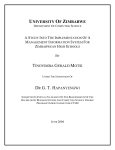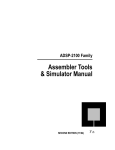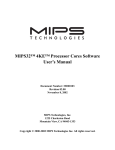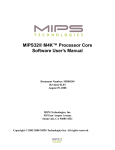Download netup - TELE-audiovision Magazine
Transcript
TEST REPORT Professional PC Card Test of the NetUP Dual DVB-T/C-CI •Suitable for setting up professional IPTV servers •Also ideally suitable for Linux based multimedia centers •Designed with longevity in mind with its modern components •Compact design with two DVB-T/C tuners and two CI slots 62 TELE-satellite International — The World‘s Largest Digital TV Trade Magazine — 12-01/2012 — www.TELE-satellite.com www.TELE-satellite.com — 12-01/2012 — TELE-satellite International — The World‘s Largest Digital TV Trade Magazine 63 TEST REPORT Professional PC Card A Professional card for professional applications under Linux The NetUP Dual DVB-T/CCI is being offered as a professional DVB-C and DVB-T PCI-e adapter and is being primarily marketed for use in IPTV servers. When the adapter arrived at our TELEsatellite test labs in an unremarkable package, we were a little concerned at first when we opened the package and couldn’t find any trace of a user manual or quick start guide; not even a driver CD could be found! As it turns out, if you pay a visit to the manufacturer’s web site you’ll find a brief overview of how to install this adapter under Linux. It is necessary to recompile the kernel in a NetUP modified kernel version 3.0.0-rc7. Prepared software has to be put together by the customers themselves. The card is tested with tzap and czap. It’s obvious that we’re not dealing with a consumer product here but rather a professional product. Linux experience is required so that the card can even be recognized by the operating system. The manufacturer wasn’t neglectful in including a written description, it’s just a simple consequence of the brand new hardware components that are used. The chips are very new and boast high power in a small space: A DVB-C or DVB-T signal can be placed on either of the two tuners. There are also two CI slots. The internal components consist of a Conexant CX23885 that can handle two MPEG transport streams and works with an integrated Sigma-Delta ADCs with 4:2 MUX. There’s also an extremely energy efficient STM STV0367 ultra compact combination DVB-T/C single chip receiver on board. This comes with 6, 7 or 8 Mhz bandwidth as well as QPSK, 16 QAM and 64 QAM modulations. 16, 32, 64, 128 and 256 constellations are supported in DVB-C mode. The tuners are Xceive XC5000 Silicon tuners that don’t need any kind of metallic shielding thus making them easier to incorporate onto the circuit board. These tuners support all the TV standards and have exceptional sensitivity even with weaker signals. For the CI slots an Altera FPGA is available. This chip is a programmable processor and by that we mean the software based arrangement of the function structure. This makes it theoretically possible to modify the CI interface to work with new developments. After the installation of the hardware in the PC, a Linux distribution must then be installed. For our case we selected an up to date Ubuntu Distribution since it can be installed rather quickly and not necessarily because of the popularity of this Linux distribution with its good support. 64 TELE-satellite International — The World‘s Largest Digital TV Trade Magazine — 12-01/2012 — www.TELE-satellite.com 12-01/2012 DVB -T/C-CI Impressive professiona l card for IPTV servers and multimedia centers that is loaded with the latest technologies for long-term use Once Linux has been installed, the Kernel, the central component of any Unix operating system, must be recompiled so that it can then recognize the NetUP card. Since the components on the card are still quite new, current Linux distributions with v2.6 won’t recognize it. NetUP provides some help as can be seen in Figure 1. However this newly installed Ubuntu Linux won’t take you all the way to the end since, for example, GIT has not yet been installed. Because of this we went ahead as described in Figure 2. Once you have accessed “make menuconfig”, three options need to be activated. These are described on the NetUP website although in our tests there were only slight differences. Figures 3, 4 and 5 show exactly what needs to be changed. The line “export CONCURRENCY_LEVEL=3” works better with a multi-core processor in which two CPU cores are used for compilation. The rule is: “CONCURRENCY_LEVEL=X where X is the number of the CPU cores used +1 After a restart GRUB should allow a boot up in the newly compiled Kernel. If any errors should occur, you should first try to compile and install an official Kernel. This should make it easier to diagnose any future problems. In many cases it’s the nVidia graphics card that is the problem. If this hap- 1 2 3 pens, you should first try to reinstall up-to-date nVidia drivers and then try to recompile the Kernel. After the first restart, it would be a good idea to have a look in /dev/dvb and check to see if both adapter0 and adapter1 are available. 1. We took this path to compile the kernel under Ubuntu 2. Under Device Drivers, Multimedia Support, DVB/ ATSC adapters, Customize DVB Frontends, ST STV0367 based (NEW) with <M> must be activated 3. Under Device Drivers, Staging drivers, Altera FPGA firmware download module with <M> must be activated 4. Under Device Drivers, Multimedia Support, Video capture adapters, Altera FPGA based CI module with <M> must be activated 7 4 5 5. After compiling the kernel successfully, you should use dmesg to check if the card was correctly recognized and incorporated into the system 6. Two simultaneous channel scans using w_scan; Adapter1 is searching for DVB-T channels while Adapter2 is scanning for DVB-C channels 9 11 66 TELE-satellite International — The World‘s Largest Digital TV Trade Magazine — 12-01/2012 — www.TELE-satellite.com As a second test you should start “dmseg” in a shell and check to see if the NetUP card was successfully initialized and that its firmware is running. If you don’t have any patience, you can start “w_scan -f t -c XX” where XX is the country code, for example, DE for Germany. With the “-ft” option you can start a DVB-T scan. The “-fc” option starts a DVB-C scan. When both of the scans have found channels, you can breath easy; the most difficult hurdles are behind you. 10 6 8 Since with Ubuntu’s Software Manager its easy to select and install “Kaffeine”, the first tests with this TV software have been completed. This doesn’t need any special explanation: you should set up the transponder list in such a way that it contains predefined transponders from your region. You can enter, for example, the following into a shell: “nano .kde/share/apps/kaffeine/scanfile.dvb“ Since this data is already predefined, there’s usually nothing that needs to be changed. If the desired transponder group is nevertheless still not there, it can easily be added since the structure of the data is for the most part self-explanatory. The last step involves starting Kaffeine and setting up the recognized DVB adapters. Four devices should have been found: Adapter0/Frontend0 (DVBT), Adapter0/Frontend1 (DVB-C) Adapter1/Frontend0 (DVB-T) and Adapter1/Frontend1 (DVB-C). Keep in mind that Apapter0 corresponds to the “F” connector next to the CI slot! Otherwise you might be wondering why no channels were found… Once a scan has been completed, the channels that were found have to be carried over. Now you can 7. Kaffeine found four devices: DVB-T Nr.1, DVB-C 1 Nr.1, DVB-T Nr.2 and DVB-C Nr.2. An individual transponder list can be set up for each device for the channel scan 8. Results of a DVB-T scan in Portugal. Unfortunately, only five channels are being transmitted on a transponder 9. Kaffeine being used as TV software - display of a DVB-T channel 10. More channels are now available after a DVB-C scan 11. VLC can also be used as TV software - here we see a channel list of a DVB-C transponder www.TELE-satellite.com — 12-01/2012 — TELE-satellite International — The World‘s Largest Digital TV Trade Magazine 67 12 comfortably watch TV with Kaffeine. This software comes with all of the typical functions you’d expect such as time shifting or recording. If you want to get into it a little deeper, simply install VDR. This ultimate TV software - VDR stands for Video Disc Recorder - gives you everything your heart could possibly desire in the form of plug-ins. Experienced Linux users can construct themselves a multimedia center that would be far better than 13 anything else available on the market! And this is exactly where the NetUP card shines: in the smallest possible space it provides two independent DVB-T/C adapters and two CI slots. In this way a multimedia center with living room compatible boxes can be created: small size and low energy usage are critical features here. The installation and configuration of VDR will not be described here; there are far too many features and it would burst out the sides of this test report. Those who are interested should find out more about yaVDR. This involves a completed distribution in which VDR is already preinstalled with all the important plug-ins and, as a bonus, also includes XBMC. Naturally the Kernel most also be recompiled here. The NetUP Dual DVB-T/CCI is specifically meant for professional applications; it has enhanced the IPTV product palette of this manufacturer. In the 10-11/2011 issue of TELE-satellite the NetUP DVB-IP Gateway 4x was tested and in the 0203/2011 issue the NetUp sister card Dual DVB-S2-CI was introduced. These two PCI-e cards, the NetUP Dual DVB-T/C-CI and the NetUP Dual DVBS2-CI were designed to be installed into IPTV servers. With that in mind, two of 14 12. The NetUP card was also incorporated into a VDR system without any problems. The advantage here: while one adapter is responsible for displaying pictures, the second adapter keeps the channel list current in the background 13. A test PC receives four streams in parallel from the IPTV server that is equipped with a NetUP Dual DVB-T/C-CI 14. Example of how VLC can operate as a streaming server 68 TELE-satellite International — The World‘s Largest Digital TV Trade Magazine — 12-01/2012 — www.TELE-satellite.com More on This Manufacturer Read TELE-satellite’s Company Report: NETUP these cards can be installed in a standard 1U rack. With a corresponding network connection and software the customer‘s requirements can be solved at an attractive price. A server can be equipped with two of these cards thus providing four complete transponders to the network. These can then be received by IPTV receivers. Hotels could then build up an inexpensive bouquet of channels out of DVB-T and DVB-C transponders that could then be made available to individual rooms. Ideal is the fact that encrypted transponders can easily be decrypted with just one SmartCard and then restreamed further down the line. This makes it simple to make encrypted DVB-T/C channels available in the IPTV stream. We thought it would be interesting to set up an IPTV streaming server in our test labs which would then be used to drive a number of PCs that would act as IPTV clients in an attempt to simulate a network load. We wanted to see how difficult it would be to set up an IPTV server with NetUP cards. We installed the wellknown VideoLAN VLC software on the server and the clients. This involves an open-source project that is available for a variety of platforms. The advantage of this solution is the ease in which our needs could be implemented. Configuration data must be set up for the server. We chose the http-protocol since it can be directly used without any excessive network configuration so that PCs with various IP addresses can access the server; that’s what a Unicast solution is all about: a stream is made available for each client in the network. as the source and http:// ipt v-addr e s s:por t /s tr eam must be entered where “iptv-address” is the IP address of the server, “port” is the port identified in the configuration data and “stream” is the corresponding stream for each channel. Our example data can be seen in Figure 15. To test this set up we opened four VLC windows and streamed four streams parallel to each other as you can see in Figure 16. On 16 three additional computers we opened four VLC windows with various channels on each of them. A total of 16 channels were streamed in parallel. The feared network bottleneck never happened. Instead an Asus EeePC turned out to be too slow to play back four MPEG4 channels at the same time. A look at the network load showed that there were still enormous reserves available as can be seen in Figure 17. Our network was a 100 Mbps network; 1000 Mbps networks are not so unusual anymore today and when it involves new construction, it’s a good idea to use the proper cabling. Real professionals naturally don’t even use VLC as streaming software, instead they use specialized streaming programs for the command lines. This has the advantage of being able to operate the IPTV server without a monitor; SecureShell (ssh) is used for access instead. An example of just such an IPTV streaming software is MumuDVB. 15. A VLC window is running as a server on the IPTV server making the streams available. As a test four additional VLC windows are running as clients and display four different channels in parallel 16. Network load with 16 parallel streamed channels in MPEG-4 format 17. MumuDVB streams a complete DVB-C transponder; czap keeps an eye on the reception quality at the same time 18. Simultaneous presentation of the MumuDVB IPTV stream; a real studio feeling comes over you! IPTV Software and Hardware Producer, Russia www.TELE-satellite.com/TELE-satellite-1101/eng/netup.pdf 17 In the configuration data each channel must have a row added that identifies what channel is to be made available on what stream. The VLC clients have to choose network streaming 15 70 TELE-satellite International — The World‘s Largest Digital TV Trade Magazine — 12-01/2012 — www.TELE-satellite.com 18 www.TELE-satellite.com — 12-01/2012 — TELE-satellite International — The World‘s Largest Digital TV Trade Magazine 71 for professional applications. It would also play an interesting role in the set up of a compact multimedia center because it would take up only one PCI-e slot and yet pro- This software doesn‘t cost anything to use and can be loaded as source code or it can be installed as a complete package for most Linux distributions. Aside from that, Multicast, not Unicast, is used to provide the IPTV stream to large networks. In this case the entire IPTV stream is available in the network and each client is able to access this stream. In order for this to work, the network infrastructure must include routers that can handle Multicasting. able to stream entire bouquets with an IPTV server via Multicasting, make sure you use compatible routers and switches. To really test the limits of the NetUP Dual DVB-T/C-CI, we decided to stream a DVB-T transponder at the same time. The card did not even blink when we did this; it functioned perfectly as you might expect from a professional product. In order to test an actual professional configuration with Multicasting, we took an entire DVB-C transponder and streamed it into our network with our own homemade IPTV server with the IPTV protocol “RTP”. This had a real “broadcasting feeling” to it! We were able to open all 12 channels at the same time on our PC. One thing though, our switch gave us some problems; as it turns out, it wasn’t really compatible with Multicasting. If you really want to be The NetUP Dual DVB-T/CCI is a professional card perfectly suited for use in IPTV servers. Because of the ability to use two of these cards in a server, the operator can stream up to two DVB-T and two DVB-C transponders. Naturally, you could also combine the NetUP Dual DVB-T/C-CI with a NetUP Dual DVB-S2-CI card. The advantage to building your own IPTV server is that you can customize it to the needs of your customers. A server like this can also of- fer additional services such as video-on-demand as well as function as a DHCP server and Internet gateway. This type of flexibility is rare with broadcasting equipment. Traditional installers should set themselves apart with this IPTV technology since it has been more and more playing a key role when it comes to communitybased systems, multi-family homes and hotels. A single cable can provide IPTV, Internet and VoiP telephone. This card is not only meant vide two individual adapters that would support not only DVB-T and DVB-C, but perhaps also Mini-ITX motherboards as well. These come with one PCI-e slot, if any at all; up until now they weren’t a very popular choice to use. This all changes with the NetUP card. Throughout our entire test in which we put the card through its paces, there were no stability or heat problems. It’s clear that this card was designed for long-term use. We were very impressed with the capabilities of the NetUP Dual DVB-T/C-CI! Expert Opinion + – Two independent tuners Each tuner can process DVB-C or DVB-T Excellent reception capabilities CI-Interface Vitor Martins Augusto Only for Linux 72 TELE-satellite International — The World‘s Largest Digital TV Trade Magazine — 12-01/2012 — www.TELE-satellite.com TELE-satellite Test Center Portugal



















